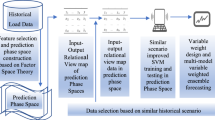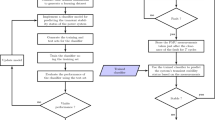Abstract
In this article we propose a concept of ensemble methods based on deconvolution with state space and MLP neural network approach. Having a few prediction models we treat their results as a multivariate variable with latent components having destructive or constructive impact on prediction. The latent component classification is performed using novel variability measure derived from Hurst exponent. The validity of our concept is presented on the real problem of load forecasting in the Polish power system.
Access this chapter
Tax calculation will be finalised at checkout
Purchases are for personal use only
Preview
Unable to display preview. Download preview PDF.
Similar content being viewed by others
References
Barabasi, A.-L., Vicsek, T.: Multifractality of self-affine fractals. Physical Review A44, 2730–2733 (1991)
Breiman, L.: Bagging predictors. Machine Learning 24, 123–140 (1996)
Bussgang, J.J.: Cross-correlation function of amplitude-distorted Gaussian signals, MIT Research Laboratory of Electronics, Technical Report 216 (1952)
Cichocki, A., Amari, S.: Adaptive Blind Signal and Image Processing. John Wiley, Chichester (2002)
Hoeting, J., Mdigan, D., Raftery, A., Volinsky, C.: Bayesian model averaging: a tutorial. Statistical Science 14, 382–417 (1999)
Hyvärinen, A., Karhunen, J., Oja, E.: Independent Component Analysis. John Wiley, Chichester (2001)
Hurst, H.E.: Long term storage capacity of reservoirs. Trans. Am. Soc. Civil Engineers 116, 770–799 (1951)
Peters, E.: Fractal market analysis. John Wiley, Chichester (1996)
Samorodnitskij, G., Taqqu, M.: Stable non-Gaussian random processes: stochastic models with infinitive variance. Chapman and Hall, New York (1994)
Szupiluk, R., Wojewnik, P., Ząbkowski, T.: Smooth Component Analysis as Ensemble Method for Prediction Improvement. In: Davies, M.E., James, C.J., Abdallah, S.A., Plumbley, M.D. (eds.) ICA 2007. LNCS, vol. 4666, pp. 277–284. Springer, Heidelberg (2007)
Szupiluk, R., Wojewnik, P., Zabkowski, T.: Noise detection for ensemble methods. In: Rutkowski, L., Scherer, R., Tadeusiewicz, R., Zadeh, L.A., Zurada, J.M. (eds.) ICAISC 2010, Part I. LNCS (LNAI), vol. 6113, pp. 471–478. Springer, Heidelberg (2010)
Weron, R., Bierbrauer, M., Trück, S.: Modeling electricity prices: jump diffusion and regime switching. Physica A 336, 39 (2004)
Zhang, L., Cichocki, A.: Blind Separation of Filtered Source Using State-Space Approach. In: Advances in Neural Information Processing Systems, vol. 11, pp. 648–654 (1999)
Zhang, L., Cichocki, A.: Blind Deconvolution of Dynamical Systems: A State Space Approach. Journal of Signal Processing 4(2), 111–113 (2000)
Author information
Authors and Affiliations
Editor information
Editors and Affiliations
Rights and permissions
Copyright information
© 2013 Springer-Verlag Berlin Heidelberg
About this paper
Cite this paper
Szupiluk, R., Ząbkowski, T. (2013). A State Space Approach and Hurst Exponent for Ensemble Predictors. In: Iliadis, L., Papadopoulos, H., Jayne, C. (eds) Engineering Applications of Neural Networks. EANN 2013. Communications in Computer and Information Science, vol 383. Springer, Berlin, Heidelberg. https://doi.org/10.1007/978-3-642-41013-0_16
Download citation
DOI: https://doi.org/10.1007/978-3-642-41013-0_16
Publisher Name: Springer, Berlin, Heidelberg
Print ISBN: 978-3-642-41012-3
Online ISBN: 978-3-642-41013-0
eBook Packages: Computer ScienceComputer Science (R0)




